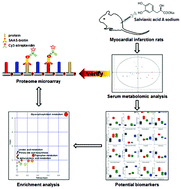当前位置:
X-MOL 学术
›
Mol. Omics
›
论文详情
Our official English website, www.x-mol.net, welcomes your
feedback! (Note: you will need to create a separate account there.)
Cardioprotective mechanism study of salvianic acid A sodium based on a proteome microarray approach and metabolomic profiling of rat serum after myocardial infarction.
Molecular Omics ( IF 3.0 ) Pub Date : 2019-05-17 , DOI: 10.1039/c9mo00005d Dan Jia 1 , Liyan Xiong 2 , Xuhong Yu 3 , Xiaofei Chen 1 , Tingfang Wang 2 , Alex F Chen 4 , Yifeng Chai 1 , Zhenyu Zhu 1 , Chuan Zhang 2
Molecular Omics ( IF 3.0 ) Pub Date : 2019-05-17 , DOI: 10.1039/c9mo00005d Dan Jia 1 , Liyan Xiong 2 , Xuhong Yu 3 , Xiaofei Chen 1 , Tingfang Wang 2 , Alex F Chen 4 , Yifeng Chai 1 , Zhenyu Zhu 1 , Chuan Zhang 2
Affiliation

|
Salvianic acid A sodium (SAAS), derived from a well-known herbal medicine Danshen (Salvia miltiorrhiza), is a new drug involved in phase I clinical trials in China for the treatment of coronary heart disease and stable angina pectoris. However, the direct binding protein(s) of SAAS are not understood and the broader cardioprotective effects as well as the underlying mechanisms remain to be further elucidated. In this study, Sprague-Dawley rats were subjected to left anterior descending artery ligation to investigate the cardioprotective effect of SAAS against myocardial infarction (MI). Moreover, a human proteome microarray was used to identify the direct binding proteins of SAAS, which was further verified by metabolomic profiling of rat serum after MI using an ultra-performance liquid chromatography/quadrupole time-of-flight mass spectrometry (UPLC-QTOF-MS) based approach. Our results demonstrated that SAAS significantly improved cardiac function and protected against MI-induced injury. In total, 370 proteins were identified to specifically bind SAAS and strikingly enriched in metabolic pathways. Rat serum metabolomic profiling identified 26 potential biomarkers including various glycerophospholipids (GPLs) and an array of fatty acids. Metabolic pathway analysis found increased phospholipid catabolism, sphingolipid metabolism and linoleic acid metabolism, decreased tryptophan metabolism, and impaired glycerophospholipid metabolism and primary bile acid biosynthesis in MI animals, while SAAS remarkably reversed these metabolic changes. SAAS may protect against myocardial infarction in rats by reversing multiple metabolic changes-induced by MI injury. Our findings will shed light on the cardioprotective mechanism of SAAS and aid its clinical use. Moreover, the SAAS-binding proteins identified by the proteome microarray are expected to be a valuable resource for its greater development.
更新日期:2019-08-05











































 京公网安备 11010802027423号
京公网安备 11010802027423号